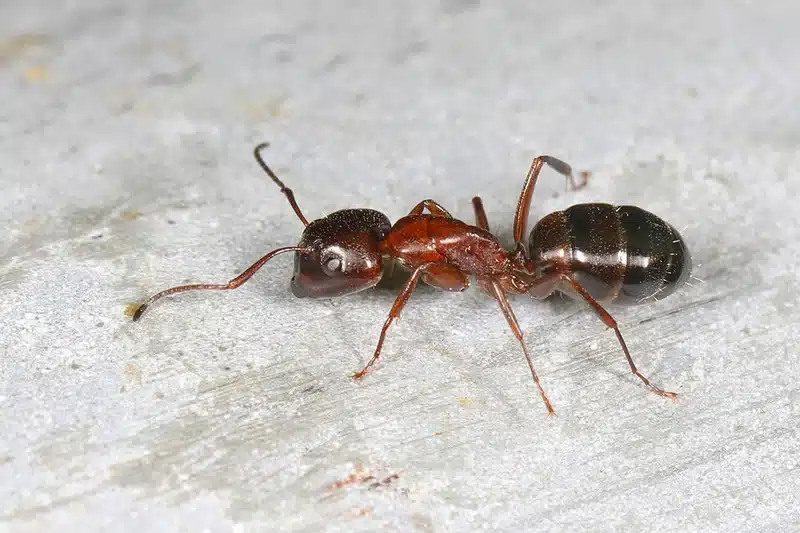Finding a large, dark ant crawling around your kitchen after you thought you dealt with an ant problem? You might have encountered a carpenter ant queen. After four years as a registered technician and being part of a family business that’s served the DMV area for over 50 years, I’ve learned that most homeowners focus on the worker ants they see. However, the real key to permanent control lies with the carpenter ant queen hidden deep in your home’s structure.
Most customers call us after spotting ants in their kitchen or bathroom. What they don’t realize is that those visible workers represent only a tiny fraction of the colony. The carpenter ant queen stays hidden, continuously producing new workers to replace the ones you kill with store-bought sprays. That’s why targeting the queen becomes absolutely critical for lasting results.
What Is a Carpenter Ant Queen?
The carpenter ant queen serves as the reproductive heart of the entire colony. Unlike the workers you typically see foraging for food, the queen’s primary job involves laying eggs and maintaining the colony’s population. She’s significantly larger than worker ants and possesses unique physical characteristics that help identify her role.
A single carpenter ant queen can live 15-25 years and produce over 1,000 eggs annually once her colony matures. This incredible reproductive capacity explains why killing worker ants alone never eliminates the problem. The queen simply replaces lost workers faster than you can eliminate them.
Understanding the worker ants you see helps put the queen’s importance in perspective. Workers represent only about 10-15% of the total colony at any given time, meaning the vast majority remains hidden with the queen.
Regional Species Background in the DMV
Here in Virginia, Maryland, and DC, we primarily deal with the black carpenter ant (Camponotus pennsylvanicus). This species creates some of the largest ant colonies in North America, with mature nests reaching 2,000-15,000 individuals. According to AntWiki, these colonies commonly establish multiple nesting sites connected by worker trails.
The secondary species we encounter is Camponotus chromaiodes, which has reddish-black coloration. Both species follow similar life cycles, but the black carpenter ant causes more structural damage due to its larger colony size.
Our service area presents ideal conditions for carpenter ant queens. Brambleton’s new construction disturbs the natural ecosystem, Chantilly’s dark red soil holds moisture near foundations, and Woodbridge’s wooded lots provide perfect nesting sites. These environmental factors make the DMV region particularly susceptible to carpenter ant infestations.
Carpenter Ant Queen Identification
Identifying a carpenter ant queen requires looking for specific physical characteristics that distinguish her from workers. The queen measures 13-18 mm in length, roughly twice the size of major workers. Her most distinctive feature is an enlarged thorax that once housed powerful flight muscles.
Wing scars provide the clearest identification marker. These appear as light, oval-shaped patches on the queen’s thorax where wings detached after her nuptial flight. Additionally, you’ll notice three small, simple eyes called ocelli arranged in a triangle on top of her head.
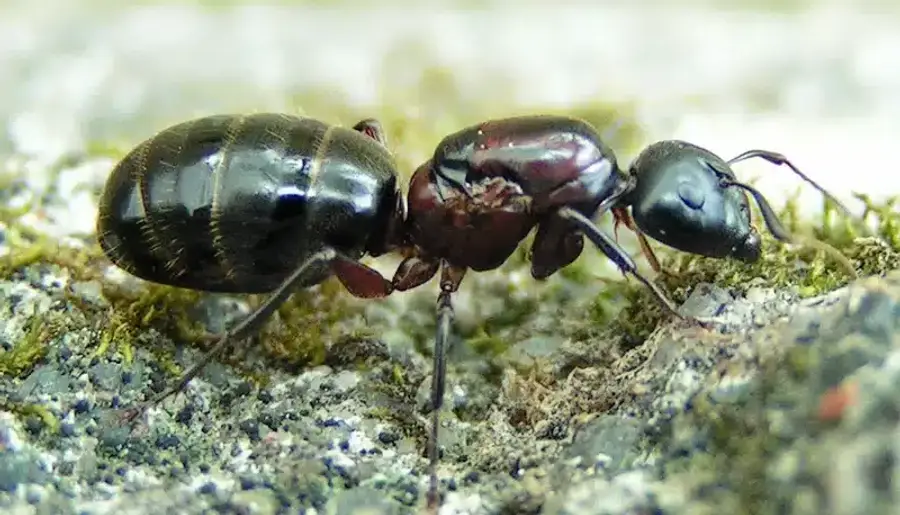
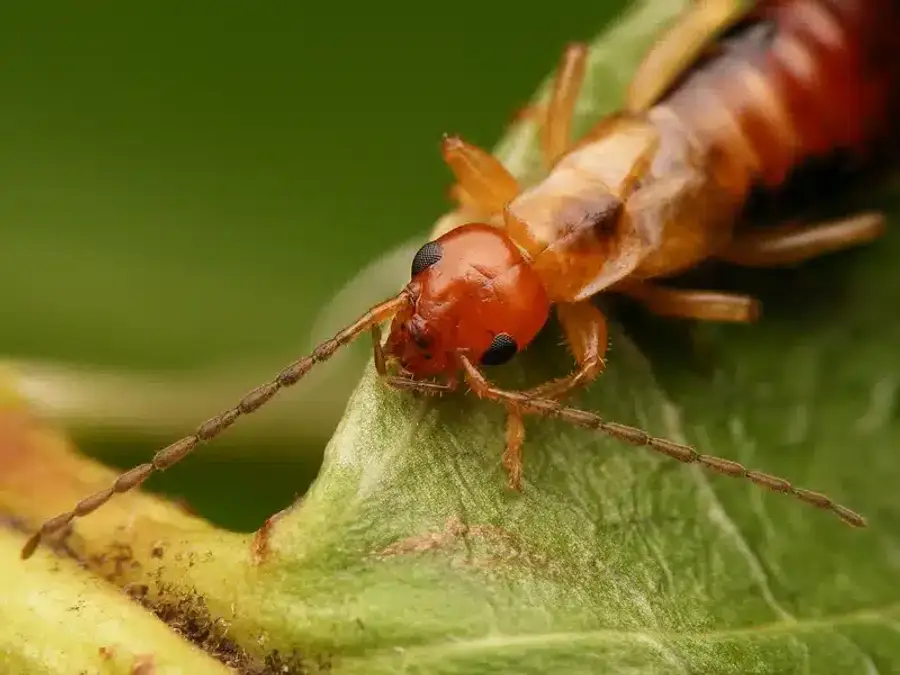
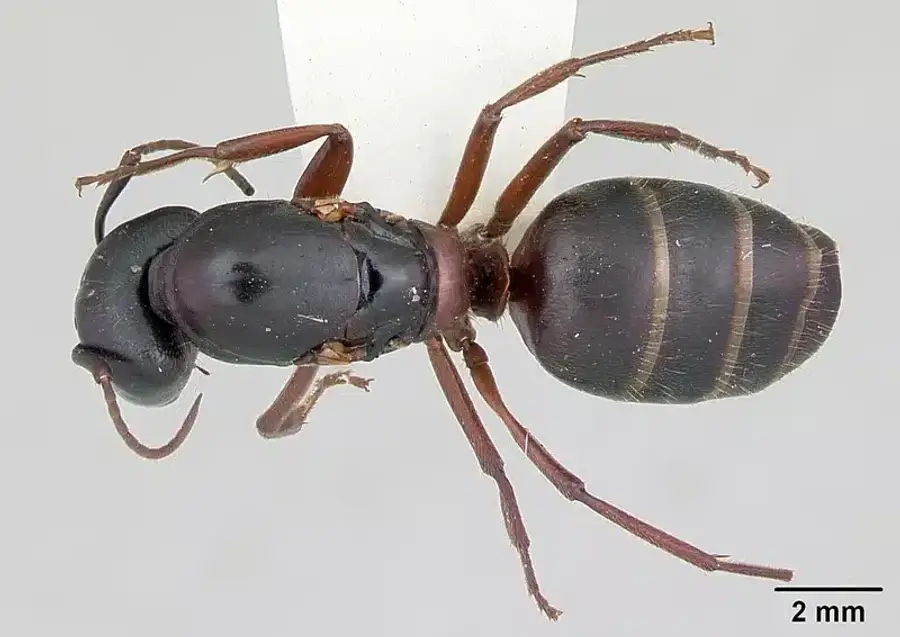
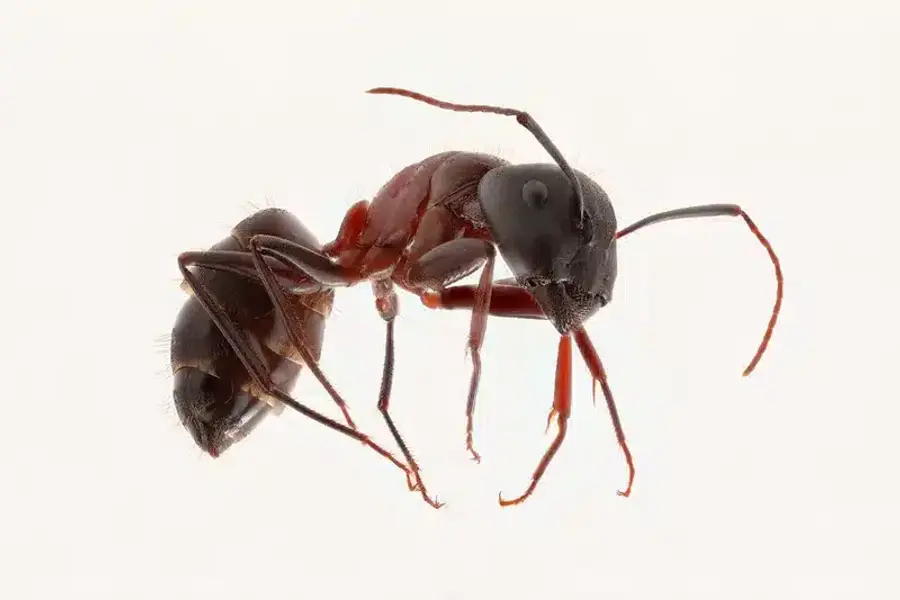
When found alive, carpenter ant queens typically fold their mandibles tightly over their heads and tuck their legs close to their bodies. This defensive posture occurs naturally during the claustral phase when queens seal themselves in founding chambers.
The coloration varies slightly between species. Black carpenter ant queens display chestnut-black coloring, while the secondary species shows more reddish-black tones. Both maintain the same general body structure and size characteristics.
Carpenter Ant Queen Life Cycle
The carpenter ant queen’s journey begins during nuptial flights, which peak in our area from late April through July. These mating swarms typically occur on warm afternoons or evenings (after 4 PM) following heavy rain. Temperature needs to reach at least 70°F for flights to begin.
During these flights, virgin queens mate with males from other colonies. Males die immediately after mating, while fertilized females land, groom themselves, and shed their wings within minutes. This brief window represents the only time homeowners typically spot queens in the open.
Once mated, the new carpenter ant queen searches for a suitable nesting site. She prefers moist wood, often choosing areas beneath bark, inside rotting stumps, or behind siding where moisture accumulates. The queen then excavates a small chamber and seals herself inside for the claustral phase.
Understanding when ants come out during the year helps predict these critical mating flights and early colony establishment periods.
First Brood Care and Development
Inside her sealed chamber, the carpenter ant queen begins her first egg clutch of 5-20 eggs. Unlike established colonies with worker support, founding queens must provide all nutrition for their initial brood. She accomplishes this through remarkable metabolic adaptations.
The queen breaks down her now-useless flight muscles to create protein-rich secretions. She feeds these nutrients directly to developing larvae and occasionally produces special “trophic eggs” that serve as additional food sources. During this 6-10 week period, she never leaves the chamber to forage.
The first workers, called nanitics, emerge significantly smaller than typical carpenter ants. These undersized workers face critical responsibility - if this initial cohort dies, the entire colony usually fails. Nanitics must quickly establish foraging routes and begin caring for subsequent broods.
This vulnerable founding period explains why early detection and treatment prove so effective. Eliminating a carpenter ant queen before she establishes worker support stops the colony permanently.
Colony Development Timeline
Year 1: The carpenter ant queen oversees 5-30 nanitic workers in a single chamber. The colony remains extremely vulnerable during this stage, focusing entirely on survival and basic expansion.
Years 2-3: Worker population grows to 50-300 individuals, displaying the full size range carpenter ants are known for. Nest galleries expand several feet in all directions, and foraging trails extend up to 30 meters from the nest.
Years 3-6: Mature colonies develop 500-3,000 workers under the carpenter ant queen’s direction. According to NC State Extension, sexual brood production begins during this period. The colony starts producing satellite nests connected to the parent location.
The growth timeline varies based on local climate conditions, available food sources, and nesting site quality. Our Mid-Atlantic climate typically extends this development process compared to warmer regions.
Mature colonies present the greatest challenge because the carpenter ant queen may be located far from visible activity. Multiple nesting sites and extensive tunnel systems make detection and treatment considerably more complex.
Satellite Colonies and Structure
As colonies mature, carpenter ant queens establish complex, multi-site operations called satellite colonies. The parent nest houses the queen, fresh eggs, and early-stage larvae, requiring high humidity levels. These primary sites typically remain in moist wood or outdoor locations.
Satellite nests contain older larvae, pupae, and workers in wood that can be much drier - even structurally sound lumber. Up to 75% of indoor infestations represent satellite colonies with no carpenter ant queen present. This fact explains why many DIY treatments fail to provide permanent control.
Workers constantly move brood between sites based on temperature and humidity conditions. When you eliminate a satellite nest, workers simply relocate to other sites or establish new ones. Without eliminating the carpenter ant queen in the parent nest, the colony regenerates quickly.
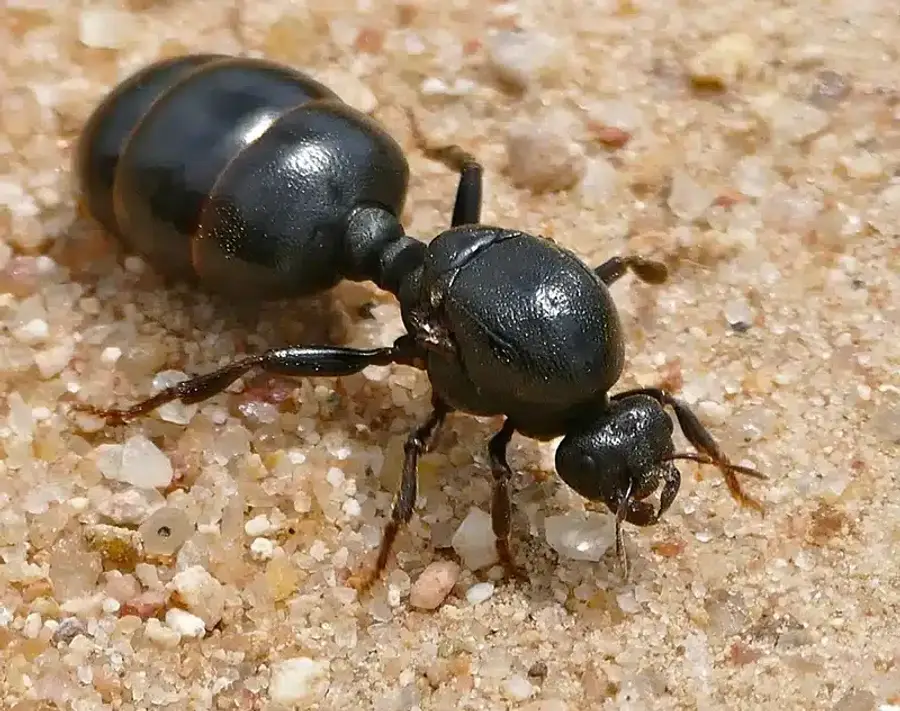
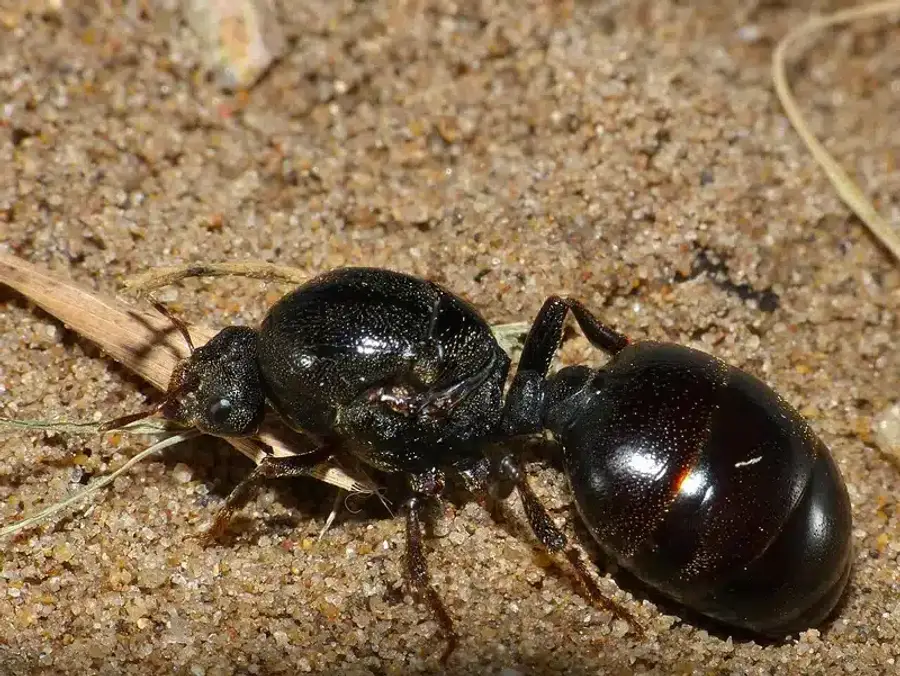
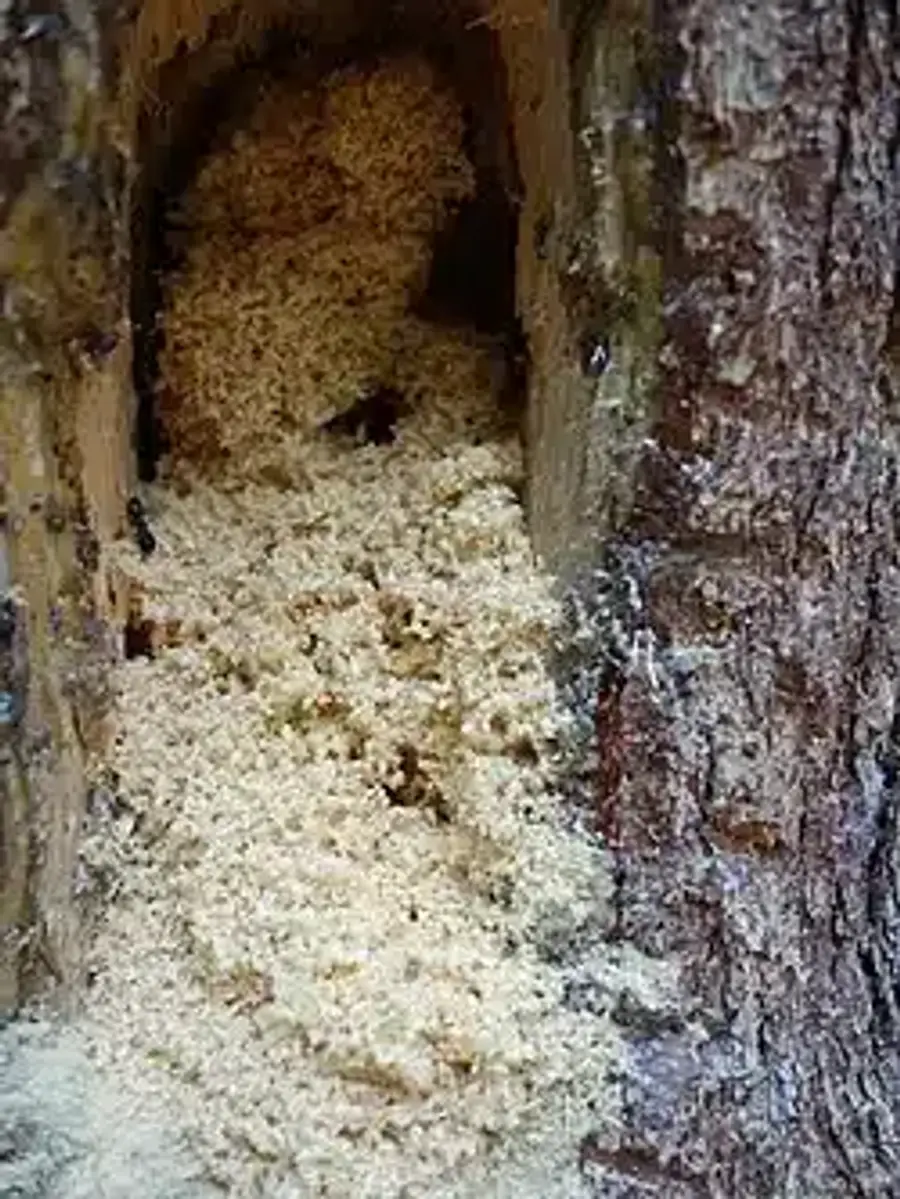
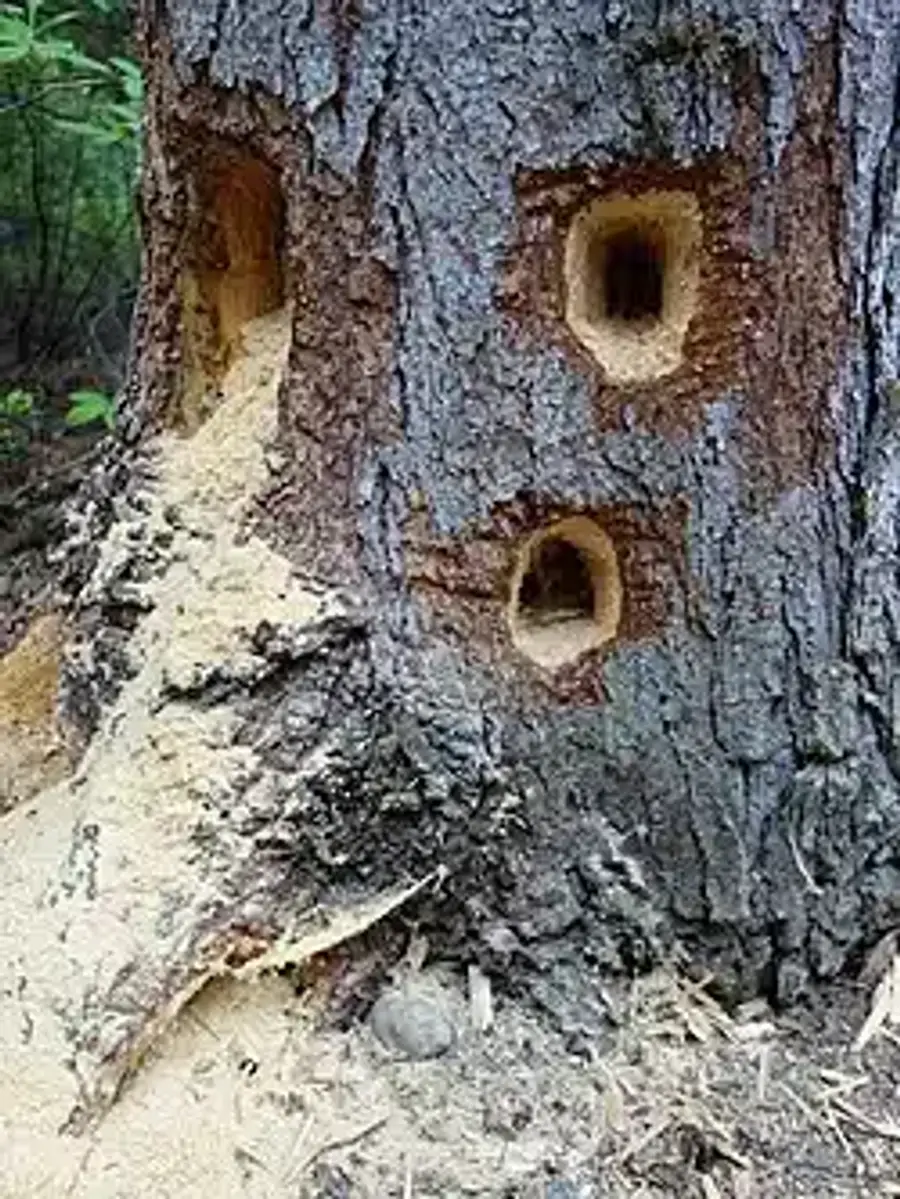
Professional treatment requires identifying the parent nest location through careful inspection and trail following. This process often involves tracing nighttime foraging activity back to high-humidity areas where queens prefer to nest.
Queen Lifespan and Reproductive Capacity
Research shows carpenter ant queens can live exceptionally long lives. Laboratory studies documented queens surviving 26 years, while field estimates for our local black carpenter ants range 15-25 years. Unlike many insects, these queens show no measurable reproductive decline throughout their extended lifespans.
Once established, a carpenter ant queen produces over 1,000 eggs annually under typical Mid-Atlantic conditions. She stores sperm from her single nuptial flight for her entire life, meaning one successful mating event can fuel decades of reproduction.
This incredible longevity and reproductive capacity highlights why queen-focused control strategies prove so important. A single carpenter ant queen can potentially produce hundreds of thousands of offspring over her lifetime. Even if you eliminate 90% of visible workers, the queen quickly replaces them.
Understanding ant lifespan patterns helps homeowners appreciate why persistent, professional treatment approaches work better than quick DIY solutions.
Queen Pheromones and Colony Control
The carpenter ant queen maintains colony order through complex chemical communication systems. She produces cuticular hydrocarbon blends that coat her eggs, marking them as legitimate and preventing workers from laying their own eggs. According to PNAS research, workers destroy any unmarked eggs within 24 hours.
These pheromone systems also regulate sexual reproduction. Primer pheromones from the carpenter ant queen suppress the development of new queens until the colony reaches approximately 2,000 workers. This built-in population control prevents premature colony division.
The queen’s chemical signals influence worker behavior, foraging patterns, and brood care activities. Disrupting these communication systems through targeted treatments can effectively destabilize entire colonies, even when the carpenter ant queen herself remains unreachable.
Professional baiting strategies often exploit these trophallaxis (food sharing) behaviors to deliver slow-acting materials directly to the queen through her own workers.
Social Structure and Multiple Queens
Black carpenter ants in our region typically maintain monogynous colonies - one reproductive carpenter ant queen per parent nest. While multiple newly-mated queens occasionally attempt founding together, mutual aggression usually results in only one survivor before the first workers emerge.
This differs from some western species and tropical carpenter ants that maintain truly polygynous (multi-queen) colonies. Our local species shows little tolerance for multiple reproductive females in established nests.
However, mature colonies do produce new winged queens during reproductive years. These potential carpenter ant queens remain in the nest until nuptial flights, creating temporary periods with multiple queens present. Only mated, egg-laying queens maintain permanent residence.
Understanding local colony structure helps pest control professionals determine appropriate treatment strategies and population estimates based on observed activity levels.
Seasonal Reproductive Cycles
Carpenter ant queens follow predictable seasonal patterns that influence both colony behavior and treatment success. From November through February, colonies enter partial diapause in response to cold temperatures. The queen stops laying eggs, and workers remain deep within galleries.
Spring reactivation begins when soil temperatures consistently exceed 50°F. The carpenter ant queen resumes egg production with a spring batch focused on workers and males. Late summer brings a second reproductive period producing future queens (gynes) that will participate in next year’s nuptial flights.
Sexual brood overwinters as pre-pupae and completes development just before spring flight season. This timing ensures newly emerged reproductives are ready for optimal mating conditions.
These seasonal patterns affect treatment success significantly. Bait acceptance and colony activity peak during June through August when metabolic rates are highest. Winter treatments often fail because colonies are semi-dormant and trophallaxis is minimal.
Finding the Carpenter Ant Queen During Treatment
Locating carpenter ant queens during professional inspections requires systematic detective work. Queens rarely leave parent nests, which can be 30+ meters from satellite nests found in kitchen walls. I’ve seen cases where homeowners dealt with indoor workers for months while the actual carpenter ant queen nested in an outdoor stump.
Parent nests typically occur in moisture-compromised wood. Common locations include:
- Roof leaks and fascia behind gutter overflows
- Stumps and firewood near foundations
- Sill plates where plumbing penetrates
- Deck posts with ground contact
We use moisture meters to identify high-humidity areas, stethoscopes to detect hollow galleries, and acoustic sensors for activity monitoring. Tracing nighttime foraging trails back to their source often reveals the parent nest location.
The most telling sign involves finding the carpenter ant queen herself or evidence of egg-laying activity during gallery excavation. Only parent nests contain fresh eggs and early-stage larvae that indicate queen presence.
Why Worker-Kill Strategies Fail
Most homeowner treatments target visible workers while ignoring the hidden carpenter ant queen. This approach fails because only 10-15% of the colony forages outside at any given time. Surface sprays reach just a fraction of the total population.
During peak summer activity, a carpenter ant queen can replace 100% of lost workers in under 60 days. She maintains steady egg production regardless of worker losses, meaning the colony rebuilds faster than most DIY treatments can eliminate it.
Store-bought sprays and ant baits often use repellent chemicals that drive workers away from treatment areas. Workers simply establish new trails around treated zones while the carpenter ant queen continues reproduction unaffected.
Without eliminating the source - the carpenter ant queen herself - treatment becomes an endless cycle of killing workers only to see new ones appear within weeks.
Professional treatment focuses on slow-acting, non-repellent materials that workers unknowingly transport back to the queen through natural food-sharing behaviors.
Effective Control Methods
Successfully eliminating carpenter ant queens requires professional-grade strategies that target the entire colony structure. Slow-acting baits prove most effective because workers transport active ingredients directly to the carpenter ant queen through trophallaxis before showing symptoms.
Foam and dust applications penetrate deep galleries where traditional sprays cannot reach. These materials create residual zones around nest sites, affecting workers as they move brood and food supplies to the carpenter ant queen’s location.
Moisture remediation addresses the root conditions that attract founding queens. Fixing roof leaks, improving drainage, and removing wood-to-soil contact eliminates preferred nesting sites and prevents recolonization.
Comprehensive treatment programs combine multiple approaches:
- Non-repellent perimeter treatments that workers cross unknowingly
- Crack and crevice applications in high-activity areas
- Targeted foam injections into suspected nest sites
- Monitoring stations to track colony response
The key involves patience - effective carpenter ant queen elimination can take 4-8 weeks as materials slowly circulate through the colony via worker activity.
Professional vs DIY Approaches
DIY carpenter ant control focuses on visible symptoms rather than the underlying carpenter ant queen problem. Homeowners can reduce attractants by sealing entry points, eliminating moisture sources, and removing wood debris near foundations. However, these preventive measures won’t eliminate existing queens.
Our approach combines third-generation expertise with research-driven product selection. We’ve removed 9 harsh chemicals commonly used in the industry, choosing alternatives like Essentria and Alpine that effectively target carpenter ant queens while being appropriate for family homes.
Professional inspection identifies parent vs. satellite nests, maps foraging trails, and pinpoints moisture conditions that support carpenter ant queen establishment. This thorough assessment guides targeted treatment strategies rather than blanket applications.
Understanding carpenter ant food sources helps professionals predict worker movement patterns and optimize bait placement for maximum queen impact.
Through 50+ years serving the DMV area, our family business has encountered every variation of carpenter ant infestation. This experience proves invaluable when tracking down elusive carpenter ant queens in complex residential structures.
Better Termite’s Queen-Focused Approach
Our carpenter ant queen elimination strategy reflects decades of field experience combined with ongoing research into colony dynamics. Rather than focusing solely on visible workers, we target the reproductive source that drives persistent infestations.
We begin with comprehensive inspections that identify all nesting sites, map foraging patterns, and locate high-probability carpenter ant queen locations. Our registered technicians use professional-grade detection equipment to pinpoint parent nests hidden within wall voids, under flooring, and in exterior structures.
Treatment materials pass through our internal research team’s evaluation process. We’ve eliminated products that create worker avoidance behaviors, choosing instead non-repellent formulations that workers unknowingly transport to carpenter ant queens.
Our unlimited callback provision ensures carpenter ant queen elimination success. If you see continued activity after treatment, we return at no additional cost until the colony is completely eliminated. This commitment reflects our confidence in queen-targeted strategies.
The Better Method includes seasonal monitoring because new carpenter ant queens can establish colonies near previous infestation sites. Annual expert reviews identify conditions that might attract future founding queens and maintain long-term protection.
If you’re dealing with persistent carpenter ant activity that returns despite repeated DIY treatments, the problem likely involves a hidden carpenter ant queen that requires professional location and elimination. Our team brings 300 years of combined experience to every carpenter ant challenge, focusing on permanent solutions rather than temporary worker suppression.
Contact us at 703-683-2000 or email info@bettertermite.com for a detailed consultation about carpenter ant queen identification and elimination strategies specific to your home’s situation.
Frequently Asked Questions
How do you identify a carpenter ant queen?
+
A carpenter ant queen measures 13-18mm long (about twice the size of workers) with an enlarged thorax and distinctive wing scars - light oval patches where wings detached after mating. She has three small eyes (ocelli) on top of her head and typically displays chestnut-black coloring. When disturbed, queens fold their mandibles over their heads and tuck their legs close to their bodies in a defensive posture.
What time of year do carpenter ant queens swarm?
+
Carpenter ant queen nuptial flights occur from late April through July in the DMV area, peaking on warm afternoons and evenings (after 4 PM) following heavy rainfall. Temperature must reach at least 70°F for flights to begin. Most swarms launch between 4 PM and midnight, typically 24-48 hours after soaking rain when humidity levels are optimal.
How long do carpenter ant queens live?
+
Field research indicates carpenter ant queens live 15-25 years under natural conditions, with laboratory studies documenting survival up to 26 years. Unlike many insects, these queens show no reproductive decline throughout their extended lifespans, continuing to produce over 1,000 eggs annually even after decades of reproduction.
Can a carpenter ant colony survive without its queen?
+
No, carpenter ant colonies cannot survive without their queen for extended periods. The queen serves as the sole reproductive source, and workers cannot lay viable eggs due to pheromone suppression. Without her continuous egg production, the colony gradually dies as existing workers reach the end of their natural lifespans (typically 1-3 years).
Why are carpenter ant queens so hard to find?
+
Carpenter ant queens remain hidden in parent nests that require high humidity levels, often located in moisture-damaged wood or outdoor sites like stumps and fallen logs. These parent nests can be 30+ meters away from visible indoor activity, which typically represents satellite colonies containing no queens. Queens rarely leave their chambers except during the brief nuptial flight period.
Will killing all the workers eliminate the carpenter ant colony?
+
Killing workers alone will not eliminate the colony because the carpenter ant queen continuously replaces lost individuals. During peak summer activity, a queen can replace 100% of workers within 60 days. Since only 10-15% of workers forage outside the nest at any time, surface treatments reach just a fraction of the total population while leaving the reproductive source intact.
How do queen pheromones affect ant colony behavior?
+
Carpenter ant queens produce cuticular hydrocarbon blends that coat their eggs, marking them as legitimate and preventing workers from reproducing. Workers destroy any unmarked eggs within 24 hours. Queen pheromones also suppress the development of new reproductive females until colonies reach approximately 2,000 workers, maintaining controlled population growth and preventing premature colony division.
Do some carpenter ant colonies have multiple queens?
+
Black carpenter ants in the Mid-Atlantic region typically maintain monogynous colonies with one reproductive queen per parent nest. While multiple newly-mated queens occasionally attempt joint founding, mutual aggression usually results in only one survivor before first workers emerge. This differs from some western and tropical species that maintain truly polygynous (multi-queen) colonies.
What triggers a nuptial flight in carpenter ants?
+
Carpenter ant nuptial flights are triggered by specific environmental conditions: temperatures reaching at least 70°F, high humidity following heavy rainfall, and low wind speeds. Flights typically occur 24-48 hours after soaking rain on warm afternoons or evenings. Barometric pressure changes and photoperiod also influence flight timing, with peak activity occurring from late April through July in our region.
How long does it take for a carpenter ant queen to establish a new colony?
+
A newly-mated carpenter ant queen requires 6-10 weeks to produce her first worker brood during the claustral phase. Full colony maturity takes 4-6 years under Mid-Atlantic conditions, progressing from 5-30 workers in year one to 500-3,000 workers capable of producing sexual brood and establishing satellite nests by years 3-6.
With five years of hands-on experience in the pest control industry, George Schulz is a registered technician with the Virginia Pest Management Association and a proud third-generation professional in a family business that's been protecting homes for over 57 years. He manages and trains a team of service pros while also leading internal research efforts—recently spearheading a deep-dive review of thousands of documents on pest control materials to hand-pick the most kid and pet friendly, most effective solutions tailored specifically for homes in the DC metro area.
